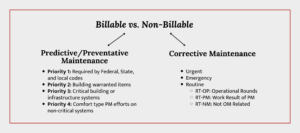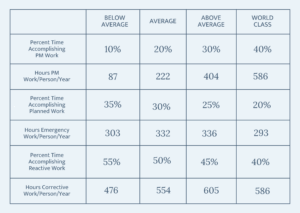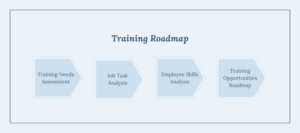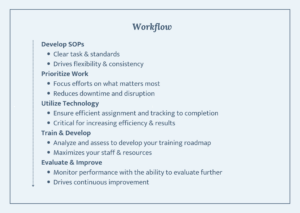
Efficient Workflow Processes to Improve the Productivity of Your Facility Maintenance Team
Understanding Current Inefficiencies
In most industries, the cost of maintenance is between 10 to 25 percent of total operating cost based on a report from McKinsey & Company. The sheer cost impact of the facility maintenance team would lead one to believe that great efforts in driving efficient processes is the norm. Unfortunately, that’s not the case, and I have observed plenty of inefficient maintenance operations throughout my career.
Examples include the “buddy” system where two people are performing the work that one should complete. Others include the lack of systems to distribute the workload, lack of materials available to complete emergency repairs along with the lack of technology to support processes. At the core of these observed inefficiencies is the lack of time and attention to workflow processes to improve productivity. Complicating the issue is the lack of understanding of facilities maintenance in business leaders, with a general trend of promoting those that solve issues during crisis versus those that can drive process improvement and balance success for the long term.
Workflow Processes to Implement for Improved Productivity and Efficiency
Efficient workflow processes are essential for improving the productivity of a facility maintenance operation. Here are the basic steps in driving toward a higher level of efficiency when leading a facility maintenance team:
1. Create Standard Operating Procedures (SOPs) for Your Common Maintenance Tasks
The first and most important step is developing basic SOPs for the maintenance task that you perform on a daily basis. These can include corrective maintenance, daily walkthroughs, equipment repairs, projects, and preventive maintenance (PM) measures. This ensures that all team members follow the same steps, reducing errors and saving time.
Maintenance tasks must be executed with clear standards to ensure work is completed properly and safely. SOPs provide maintenance teams with clear procedures on how to carry out the work, ensuring consistency in approach and minimizing the risk of equipment failure or downtime. They provide a standardized approach to performing tasks, leaving no room for ambiguity or error when employees perform their operational tasks.

In my career, maintenance operations differentiate themselves through the basics of having SOPs. Where no SOPs exist, the team relies on specific team members to know how things should be accomplished or relies heavily on third parties. This results in increased risk and downtime when these critical employees are not around. Additionally, the greater reliance on third parties results in a higher cost for operations. Bottom line, SOPs allow for greater flexibility and team collaboration, resulting in a higher level of consistency and efficiency.
2. Have a System to Prioritize Work & Resources
Implement a system for prioritizing maintenance tasks and resources based on urgency and impact on operations. This helps the team focus their efforts on what matters most, reducing the downtime for critical issues and minimizing disruptions. Below is a general representation of how maintenance tasks can be segmented and prioritized to ensure proper prioritization. Both corrective and preventative (along with planned) maintenance work orders can be segmented based on priority, with each having a standard time for completion:

Beyond completing critical tasks, prioritization allows facility leaders to make strategic decisions to improve operations. The tracking of preventive versus corrective gauges both the staffing level and condition of the facilities. Thus, supporting additional staffing needs and the need to upgrade equipment over time.
Another common gauge is the volume of preventative versus corrective work orders, with teams striving to the combined world-class level of 80 percent planned and preventative work on a routine basis. For more advanced operations that perform projects, tracking projects is a recommended addition to support successful outcomes. The general standards below can be utilized to gauge where your team and facilities are performing:

Additionally, it’s important to develop a scheduling system to allocate resources effectively and ensure that maintenance tasks are completed in a timely manner. The next item focuses on technology to make sure this happens.
3. Invest in Technology to Enhance Work Processes
The core technology for a facilities team is a Computerized Maintenance Management System (CMMS) and the basic functions are shown below:

Years ago, in my first FM leadership role, I took over an operation that was still using paperwork orders to complete tasks. As I talked with customers, they were frustrated when the office said their requests were routinely lost. We quickly convinced hospital leadership to invest in a CMMS system that increased productivity overnight. Work orders were entered and tracked till completion, and we were able to implement a PM program to enhance equipment performance. There are numerous CMMS systems on the market to fit your budget and operations, so evaluate what fits best and implement.
Radios and pagers have traditionally been the tool for communications, but the advancement of cell phones and associated apps have led most teams to provide for all technicians as the primary communication tool. CMMS and other systems utilized in facilities today provide phone apps to drive paperless and real time work record keeping, along with other support capabilities. These tools are great differentiators in driving operational efficiency when utilized properly. In the end, these tools allow for real-time updates, enhance collaboration, and reduce the risk of miscommunication.
4. Make Time to Ensure Training and Skills Development
Just like other industries, an aging maintenance workforce is preparing to retire while most entities have scaled down or eliminated their maintenance training efforts. Meanwhile, a younger workforce is entering the market largely untrained and yet responsible for maintaining complex and expensive equipment with less scheduled access to these assets than any time in history. Knowing this, it is imperative that organizations utilize highly skilled maintenance resources. Investing in training and skill development programs to enhance the expertise of the maintenance team is mission-critical. I recommend utilizing the following process to effectively develop your roadmap:
It is important to start with an objective Training Needs Assessment that encompasses three key areas:
- First, verify the critical systems and assets at your facility your staff will maintain.
- Second, use your site’s Computerized Maintenance Management System to gain an understanding of recurring equipment failures, which will aid in confirming which skill sets to concentrate on.
- Finally, identify the skill sets required to maintain the critical and frequently failing systems.
After the Training Needs Assessment, it is time to conduct a Job Task Analysis that will assist in further defining the critical skills you need to develop at your site. Before completing your plan, the next step is to find out how the current team responsible for possessing these skills are equipped by performing an Employee Skills Analysis. Once the agreed-upon skill assessments are performed, it is time to review where the training opportunities reside and develop a training roadmap to fit your staff and operations.

5. Have a Process in Place to Report and Evaluate Your Performance
Top performing facilities teams bring it all together by routinely reporting operational performance. Beyond work order completion rates already discussed, facilities teams traditionally report labor hours, safety training, budget performance, and status of special projects, along with highlighting employees and team events. As illustrated in the examples below, these reports can be provided in a variety of ways and customized to your specific facility and leadership:

Evaluation of the reporting results allows facility leaders to identify trends, optimize processes, and make data-driven decisions to improve productivity. In the end, the facilities leader must drive a culture of continuous improvement where team members are encouraged to identify inefficiencies and propose solutions. Regular feedback sessions and performance reviews are additional measures that can help identify areas for improvement and implement necessary changes.
Final Thoughts
Maintenance teams play a critical role in the success of the facilities they take care of. The steps discussed in this article provide a simple roadmap to help you drive your facility maintenance team and operations to the highest level. When you implement the type of strong workflow processes described here, you will differentiate yourself as a facilities leader.

If you are not experienced and you do not know where to start, find a mentor in your organization or find a facilities organization where you can learn and make connections. Additionally, there are companies that can guide you in the process or address specific areas where you need help.




